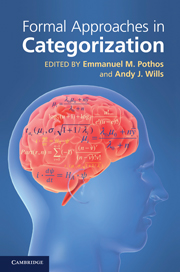Book contents
- Frontmatter
- Contents
- List of figures
- List of tables
- List of contributors
- 1 Introduction
- 2 The generalized context model: an exemplar model of classification
- 3 Prototype models of categorization: basic formulation, predictions, and limitations
- 4 COVIS
- 5 Semantics without categorization
- 6 Models of attentional learning
- 7 An elemental model of associative learning and memory
- 8 Nonparametric Bayesian models of categorization
- 9 The simplicity model of unsupervised categorization
- 10 Adaptive clustering models of categorization
- 11 Cobweb Models of Categorization and Probabilistic Concept Formation
- 12 The knowledge and resonance (KRES) model of category learning
- 13 The contribution (and drawbacks) of models to the study of concepts
- 14 Formal models of categorization: insights from cognitive neuroscience
- 15 Comments on models and categorization theories: the razor's edge
- Index
- References
5 - Semantics without categorization
Published online by Cambridge University Press: 05 June 2012
- Frontmatter
- Contents
- List of figures
- List of tables
- List of contributors
- 1 Introduction
- 2 The generalized context model: an exemplar model of classification
- 3 Prototype models of categorization: basic formulation, predictions, and limitations
- 4 COVIS
- 5 Semantics without categorization
- 6 Models of attentional learning
- 7 An elemental model of associative learning and memory
- 8 Nonparametric Bayesian models of categorization
- 9 The simplicity model of unsupervised categorization
- 10 Adaptive clustering models of categorization
- 11 Cobweb Models of Categorization and Probabilistic Concept Formation
- 12 The knowledge and resonance (KRES) model of category learning
- 13 The contribution (and drawbacks) of models to the study of concepts
- 14 Formal models of categorization: insights from cognitive neuroscience
- 15 Comments on models and categorization theories: the razor's edge
- Index
- References
Summary
Human beings have a remarkable ability to attribute meaning to the objects and events around them. Without much conscious effort, we are able to recognize the items in our environment as familiar ‘kinds’ of things, and to attribute to them properties that have not been observed directly. We know, for instance, that the banana on the kitchen counter has a skin that easily peels off, and that beneath the peel we will find a soft yellow-white interior. We know that the banana is meant to be eaten, and can anticipate what it will taste like. Such inferences spring readily to mind whether we observe the banana itself or, as with this paragraph, simply read or hear statements referring to bananas. The cognitive faculty that supports these abilities is sometimes referred to as ‘semantic memory’, and a key goal of much research in cognitive psychology is to understand the processes that support this aspect of human cognition.
One long-standing hypothesis places categorization at the heart of human semantic abilities. The motivation for this view is that categorization can provide an efficient mechanism for storing and generalizing knowledge about the world. As Rosch (1978) put it, ‘…what one wishes to gain from one's categories is a great deal of information about the environment while conserving finite resources as much as possible.’
- Type
- Chapter
- Information
- Formal Approaches in Categorization , pp. 88 - 119Publisher: Cambridge University PressPrint publication year: 2011
References
- 4
- Cited by



